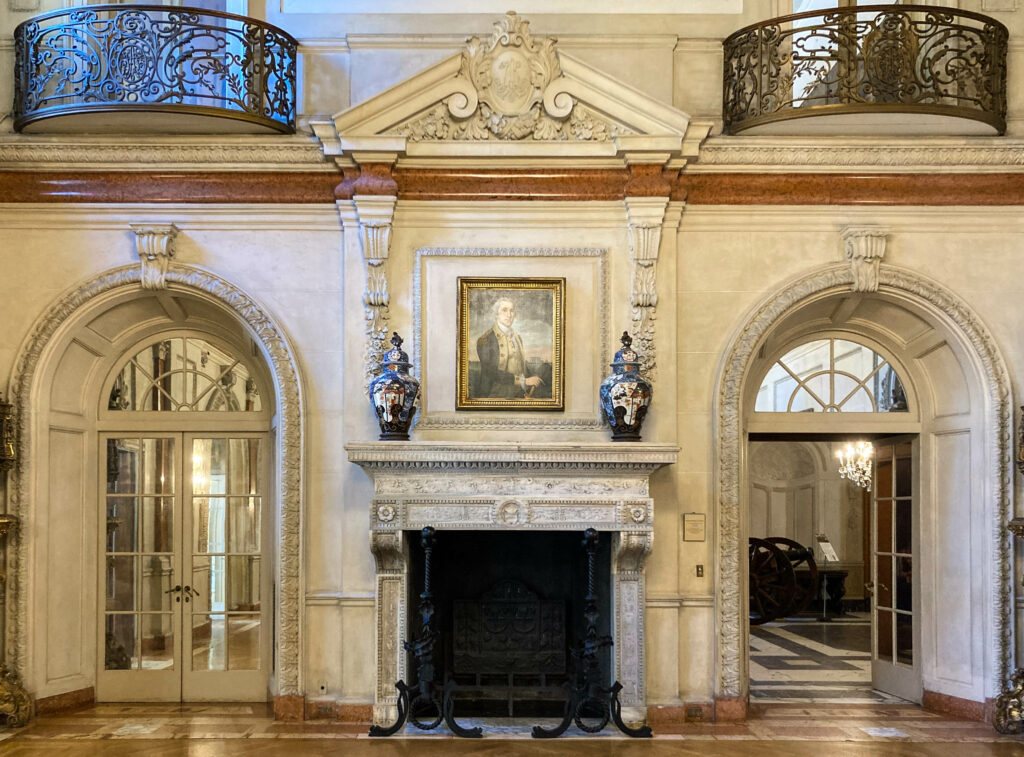A Revolutionary War cannon sits atop the marble floor of the Gilded Age mansion.
Anderson House in Washington, D.C., is not your typical museum. It resembles an intriguing meld of Newport cottage and 18th-century attic.
History of Anderson House
The 50-room, five-storey beaux-arts mansion was the winter home of Larz Anderson, an American diplomat, and his wife, Isabel Perkins Anderson, an author and philanthropist. The unique interior features carved wood walls, gilded papier-mâché ceilings, ornate iron staircases, and intricate marble floors. Completed in 1905, it became one of the District’s most fashionable houses, entertaining guests including Calvin Coolidge and Winston Churchill.
Larz Anderson died in April 1937. The following year, Isabel Anderson donated the house to the Society of the Cincinnati, to use as its national headquarters. General George Washington and 35 other Continental Army officers had founded the Society in 1783 to remember and honor the achievement of American independence. Early officers included Generals Washington, Horatio Gates, and Henry Knox.
Today’s members comprise male descendants of Revolutionary War officers. Larz Anderson had become a member while serving as an Army officer in the Spanish-American War.
The society inducted Isabel Anderson as an honorary member in thanks for her generosity. It was also her wish that the house serve as a museum, and it opened as one in 1939. Anderson House continued its tradition as the venue for some of Washington’s most fashionable events; the diplomatic corps hosted a reception at the magnificent mansion for Tricia Nixon and her fiancé Edward Cox a week before their White House wedding in 1971.
In 2012, the Society created the American Revolution Institute to renew appreciation for the history and ideals of those who fought for independence.
Museum at Anderson House
Visitors to Anderson House may take a docent-led tour the first two floors of the house. I’ve been several times and always notice something new. The mansion is furnished with art and artifacts collected by the couple during their broad travels around the world, including English paintings, French furniture, Flemish tapestries, and Asian ivories, lacquerware, screens, and sculptures.
Alongside these items are portraits, armaments, personal artifacts, and other objects commemorating the Revolutionary War and its soldiers. One of my favorite works is the magnificent mural depicting General Washington inducting the Marquis de Lafayette into the Society of the Cincinnati.
An exhibit gallery hosts changing displays on Revolutionary history, the Society of the Cincinnati, and the Andersons and their home.
There is also a research library with a focus on 18th-century military history. The House also hosts public educational programs to spread knowledge about the American Revolution and the Andersons’ lifestyle in the Washington of the Gilded Age. Thousands of people visit Anderson House annually. It’s a hidden gem for history lovers.
This post contains affiliate links. For more information, click here.
What to know before You go to
Anderson House
Anderson House is located at 2118 Massachusetts Avenue, Washington, D.C., on Embassy Row near DuPont Circle. It is free and open to the public. Allow an hour for the guided tour of the house, plus 15-20 minutes to browse the exhibit gallery.
Many of the educational programs presented by the American Revolution Institute are free; they are also live-streamed for those outside the Washington area. The presentations are excellent, featuring credentialed historians with in-depth knowledge of particular aspects of the Revolution. The research library is free and open by appointment.
The closest Metro stop is DuPont Circle, on the Red line. There is no on-site parking. I usually Uber.
There is no café. There is a tiny gift display in the foyer.
Excellent hotels within walking distance include:
Planning travel to the mid-Atlantic? You might enjoy:
- Edgar Allan Poe House and Museum in Baltimore, Maryland
- Johnson Victrola Museum in Dover, Delaware
- Lafayette Square in Washington, D.C.
After my misspent youth as a wage worker, I’m having so much more fun as a blogger, helping other discerning travellers plan fun and fascinating journeys. Read more …

